

A well-executed Salesforce implementation can increase sales productivity by up to 29%. The required investment needs careful thought. Budget overruns and delayed deployments happen because many businesses can't estimate their Salesforce implementation cost accurately.
The price tag for Salesforce implementation changes by a lot based on several factors. Small businesses might spend $25,000 to $65,000. Enterprise-level implementations can cost more than $500,000. These numbers cover everything from licensing and customization to data migration and training costs.
This piece gets into the main cost elements of Salesforce implementation in 2024. Readers will learn about core expenses, hidden costs, and how to pick the right implementation partner. They'll also find the quickest way to calculate ROI. CISIN's exceptional experience in Salesforce implementation services helps businesses of all sizes make informed decisions.
Breaking Down Core Implementation Expenses
Organizations need to understand Salesforce implementation's core expenses to budget well. The total cost of implementation ranges from $10,000 for simple projects to over $200,000 for complete implementations.
License and subscription fees by edition
Salesforce's pricing tiers accommodate different business needs. Here's Sales Cloud's current pricing structure:
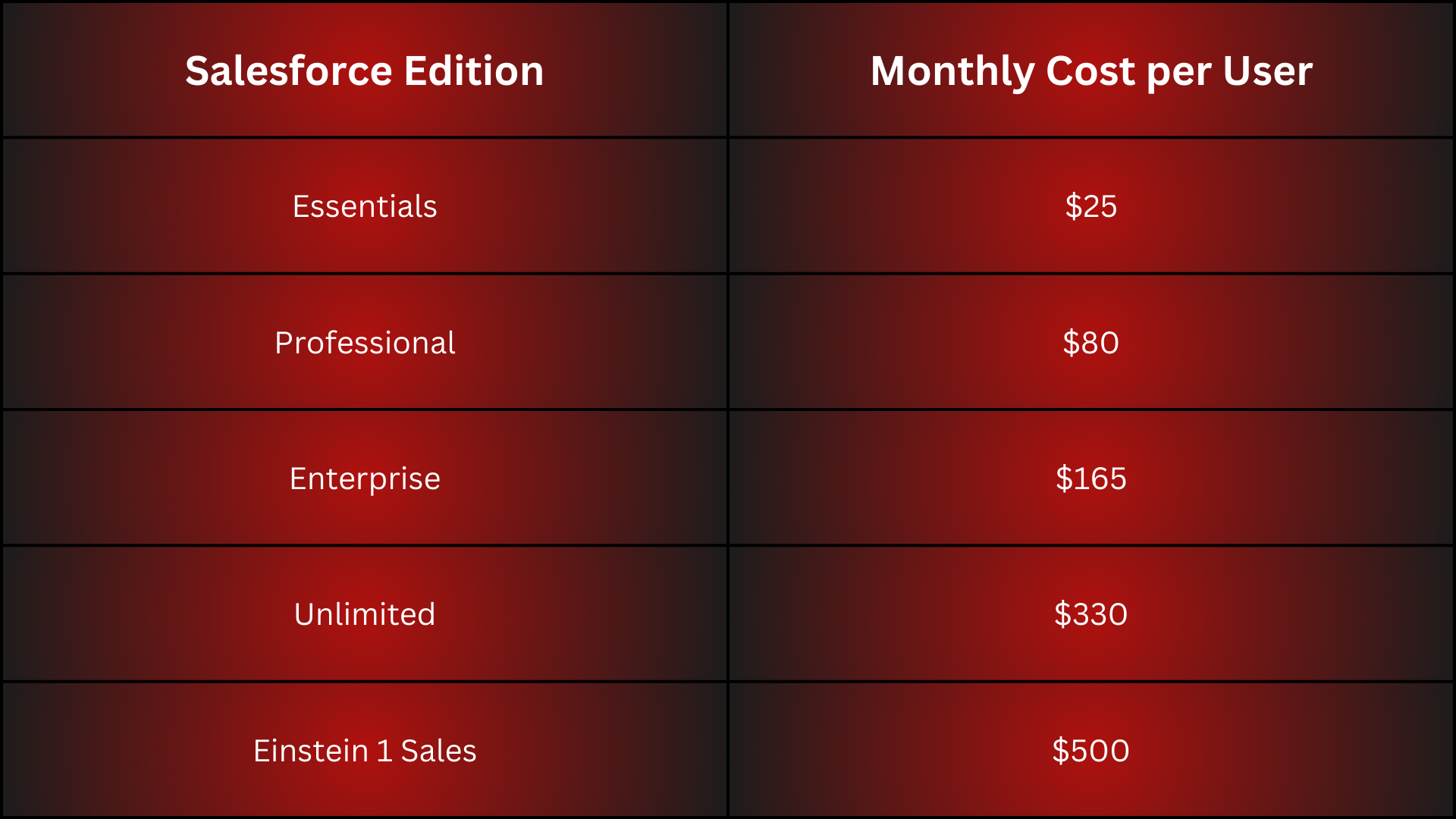
Companies must buy licenses yearly, despite monthly pricing. CISIN's implementation experts suggest careful evaluation of business requirements before choosing an edition because switching later costs more.
Data migration and cleansing costs
Data migration makes up much of the implementation expenses, ranging from $5,000 to $50,000. These factors determine the cost:
- Data volume and complexity
- Current data quality
- Number of source systems
- Required data transformations
- Automation requirements
Bad data costs businesses 15-25% of their revenue. A well-laid-out data migration approach verifies accuracy, cleans errors, and maps properly to Salesforce's organization structure.
Training and change management expenses
Training investments directly shape user adoption rates. Mid-sized companies with sales, marketing, and customer service departments might spend up to $5,000 on training. The final cost depends on:
Each user's original training costs $1,000 to $5,000, while ongoing support adds 20-30% yearly. Post-implementation support should be factored in. It usually runs three months after deployment and costs between $5,000 to $45,000 per project.
Change management, which involves stakeholders and redesigns processes, usually takes 15-20% of the total implementation budget. This investment helps get better returns through proper system use and user adoption.
Read More: Salesforce Implementation Guide: Elevate With Step-By-Step Mastery
Hidden Cost Factors to Consider
Organizations need to look beyond simple setup costs for Salesforce. There are several hidden expenses that can affect their budget in unexpected ways. These overlooked elements can add up quickly to the total investment.
Integration with existing systems
System integration costs typically range from $3,000 to $50,000. The final price depends on:
- Number of systems that need to sync
- Integration method (pre-built connectors vs custom API)
- Data sync frequency needs
- Interface modification complexity
- Security protocol setup
AppExchange offers connector apps for many systems, which helps reduce integration costs. Pre-built connectors aren't always available, so organizations might need solutions like Zapier or custom-coded integrations.
Custom development requirements
Custom development needs substantial investment, with prices from $5,000 to $100,000. The price varies based on specific business needs such as:
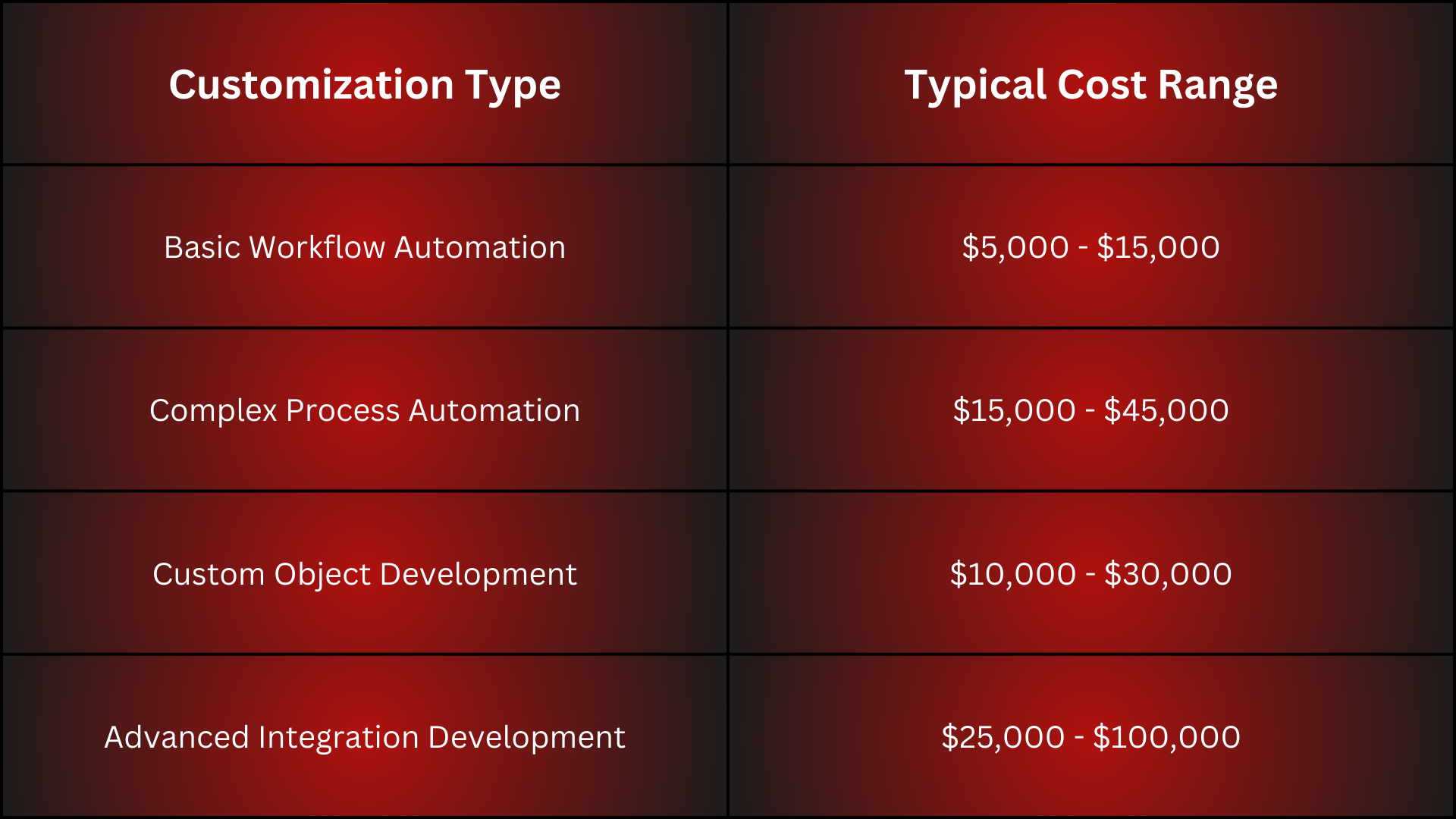
CISIN's implementation services focus on smart customization planning. This helps cut unnecessary development costs and maximizes business value.
Ongoing maintenance and support
Support after implementation usually lasts three months, with costs between $5,000 and $45,000 per project. Organizations can choose between two options for ongoing maintenance:
- Internal Team: Hiring full-time Salesforce experts ($100,000/year salary)
- Outsourced Support: Monthly retainers or project-based fees
Regular updates and support cost between $1,000 to $5,000 monthly. Complex setups with extensive customizations might need bigger maintenance budgets that exceed $5,000 monthly.
Third-party apps create additional expenses. Marketing tools like Pardot cost between $1,250 to $15,000 monthly. Each new app enhances functionality and adds to the implementation budget.
Platform reviews should happen every one to two months. These reviews help spot issues early, find ways to improve, and keep the system running smoothly.
Implementation Partner Cost Analysis
Your choice of implementation partner substantially affects how successful your Salesforce deployment will be. Companies must choose between working with freelance consultants or established agencies.
Freelance vs agency pricing comparison
A notable pricing gap exists between freelancers and agencies. Freelance consultants' fees are 40% less than agency rates. Freelancers' rates range from $25-$250 per hour, while agencies charge between $80-$250 per hour.
Key differences between freelancers and agencies:
- Freelancers excel at smaller projects and standard features
- Agencies provide detailed services and industry expertise
- Freelancers give more flexibility in engagement
- Agencies deliver better support for complex implementations
Hourly rates and project-based fees
Consultant rates vary by region and experience. Here's a breakdown of hourly rates in major markets:

The market has three main pricing models:
- Fixed Cost: Best for large-scale projects ($500-$100,000)
- Monthly Retainer: Ideal for ongoing support ($200-$350)
- Hourly Basis: Most flexible option ($20-$250 per hour)
CISIN and other vendor evaluations
CISIN distinguishes itself through its phased approach to project management. Their certified consultants help streamline processes while managing costs effectively.
Leading vendors offer these advantages:
- Certified expertise in Salesforce products
- Industry-specific implementation experience
- Detailed training programs
- Post-implementation support services
Project scope and budget constraints should guide your choice between implementation partners. Small businesses can benefit from freelance consultants for simple implementations, while enterprise-level projects need full-service agency support.
Complex implementations are more economical with established partners than building an in-house team. A team of four Salesforce administrators costs approximately $389,652 annually in salaries alone, making partner engagement a smart choice.
Cost Optimization Strategies
Cost management is crucial for successful Salesforce deployments. Organizations can reduce their implementation expenses by a lot through careful planning and systematic execution.
Phased implementation approach
A phased Salesforce rollout helps achieve faster returns on investment. Business units get ROI earlier compared to traditional deployment methods. The implementation splits into manageable segments:
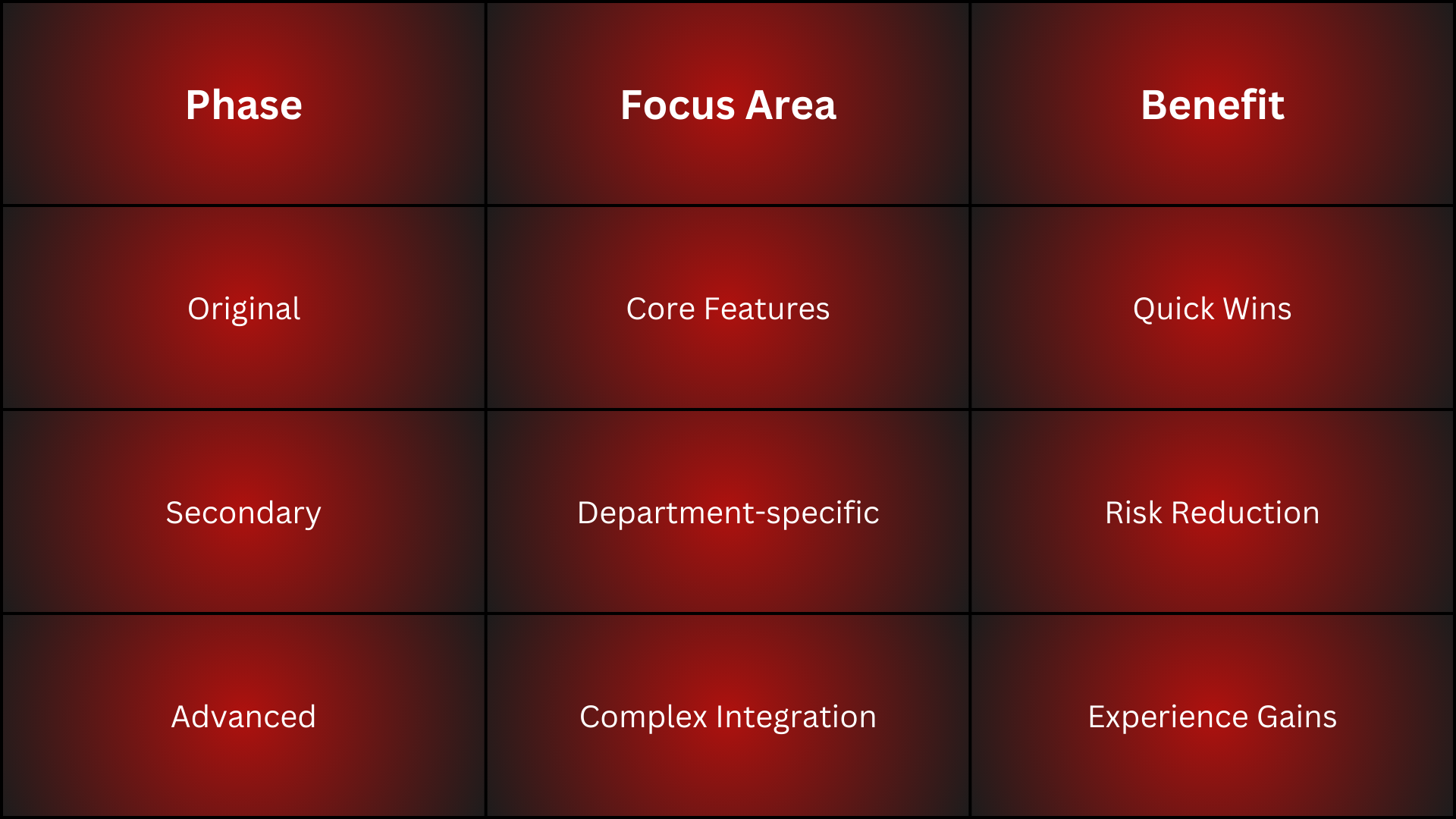
This method reduces testing complexity and minimizes oversight risks. User adoption rates improve as smaller groups adapt to changes step by step.
Resource allocation planning
Smart resource management can cut implementation costs by 25-35%. These key areas need attention:
- Cloud-based resource management tools integration
- Live capacity tracking
- Skill-based task assignment
- Automated scheduling systems
Rate cards are vital for resource cost management. Different regions need different pricing structures based on local market conditions. CISIN's Salesforce implementation services suggest creating clear rate cards before starting the project.
Budget optimization techniques
Strategic planning helps reduce implementation costs. Clear objectives and priorities form the foundations of a well-laid-out approach. Regular assessment of Salesforce licenses can generate substantial savings.
Budget optimization works best with these proven strategies:
- Quick deactivation of unused licenses
- Making use of out-of-box features before customization
- Learning about AppExchange for pre-built solutions
- Investment in complete user training
Quick Start packages are economical implementation options, ranging from $2,500 to $15,000. These packages enable rapid deployment without losing essential functionality.
System audits identify areas where costs can be cut. User activity reviews should happen every 1-2 months. This helps optimize license allocation and spot unnecessary expenses.
Training investments cut long-term support costs. Users who are well-trained make the most of platform capabilities and need less expensive external support. Organizations with complete training programs work more efficiently and ask for fewer customizations.
Implementation timeline affects overall costs by a lot. A typical Sales Cloud or Service Cloud implementation spans 4-6 months. Phase-wise implementation lets organizations spread costs while making steady progress toward their goals.
ROI Calculation Framework
ROI measurement is the life-blood of any Salesforce implementation project. Nucleus Research shows that companies using Salesforce get an average ROI of 47% and see returns in just 3.8 months.
Measuring implementation success
Organizations need success metrics to track their implementation progress. The SMARTE framework offers a well-laid-out approach to define these metrics:
- Specific goals and outcomes
- Measurable performance indicators
- Achievable targets
- Relevant to business objectives
- Time-bound milestones
- Ethical considerations
Organizations should arrange their Key Performance Indicators (KPIs) with specific business goals. A balanced scorecard approach has:
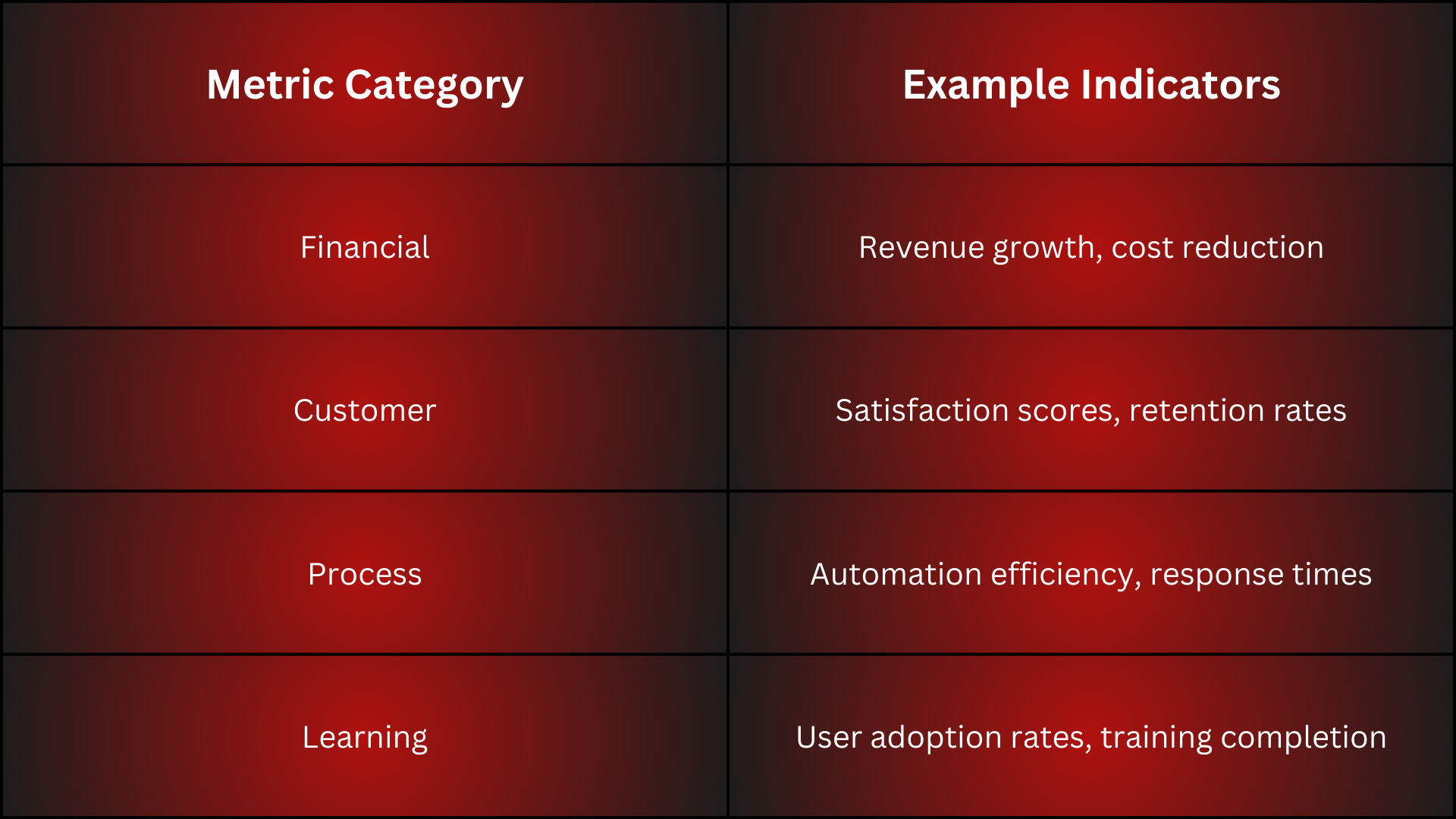
Cost-benefit analysis methods
The standard ROI calculation uses this formula: ROI = (Net Income / Total Cost) × 100
Salesforce implementations need these ROI variations:
- Simple ROI = (Net Benefits - Implementation Costs) ÷ Implementation Costs × 100
- Annualized ROI = Quarterly ROI × 4
CISIN's implementation services suggest setting baseline metrics before deployment to measure improvements accurately. Companies achieve project payback of 58% within the first year.
Payback period estimation
Several factors determine the payback period:
- Direct Benefits:
- Revenue increase (up to 37% reported)
- Operational cost reduction (43% IT cost decrease over 4 years)
- Improved productivity (26% reduction in emails)
- Indirect Benefits:
- Better customer relationships
- More accurate data
- Efficient business processes
Teams should track both quantitative and qualitative benefits. Early adoption metrics and sentiment indicators help predict long-term success.
Implementation success associates strongly with:
- Clear goal definition
- Regular performance monitoring
- User adoption rates
- Data quality maintenance
The ROI evaluation timeline typically shows:
- Short-term (3-6 months): Original efficiency gains
- Mid-term (6-12 months): Process improvements
- Long-term (1-2 years): Strategic benefits
Companies that use complete ROI tracking systems see 300-500% returns over four years. These substantial returns come from efficient operations and better customer relationships.
A full ROI assessment needs organizations to:
- Document baseline metrics
- Track implementation costs
- Monitor performance indicators
- Measure user adoption rates
- Calculate efficiency gains
Net Promoter Score (NPS) and customer retention rates work well as success indicators. These metrics need time to show meaningful trends.
Read Also: Salesforce Implementation Checklist!
Risk Mitigation and Cost Control
Risk management actively controls Salesforce implementation costs. Research indicates up to 70% of CRM implementations face major challenges. Companies need to spot potential risks early and create clear strategies to address them.
Common implementation pitfalls
Success in implementation relies on avoiding mistakes that increase costs. Organizations commonly face these challenges:
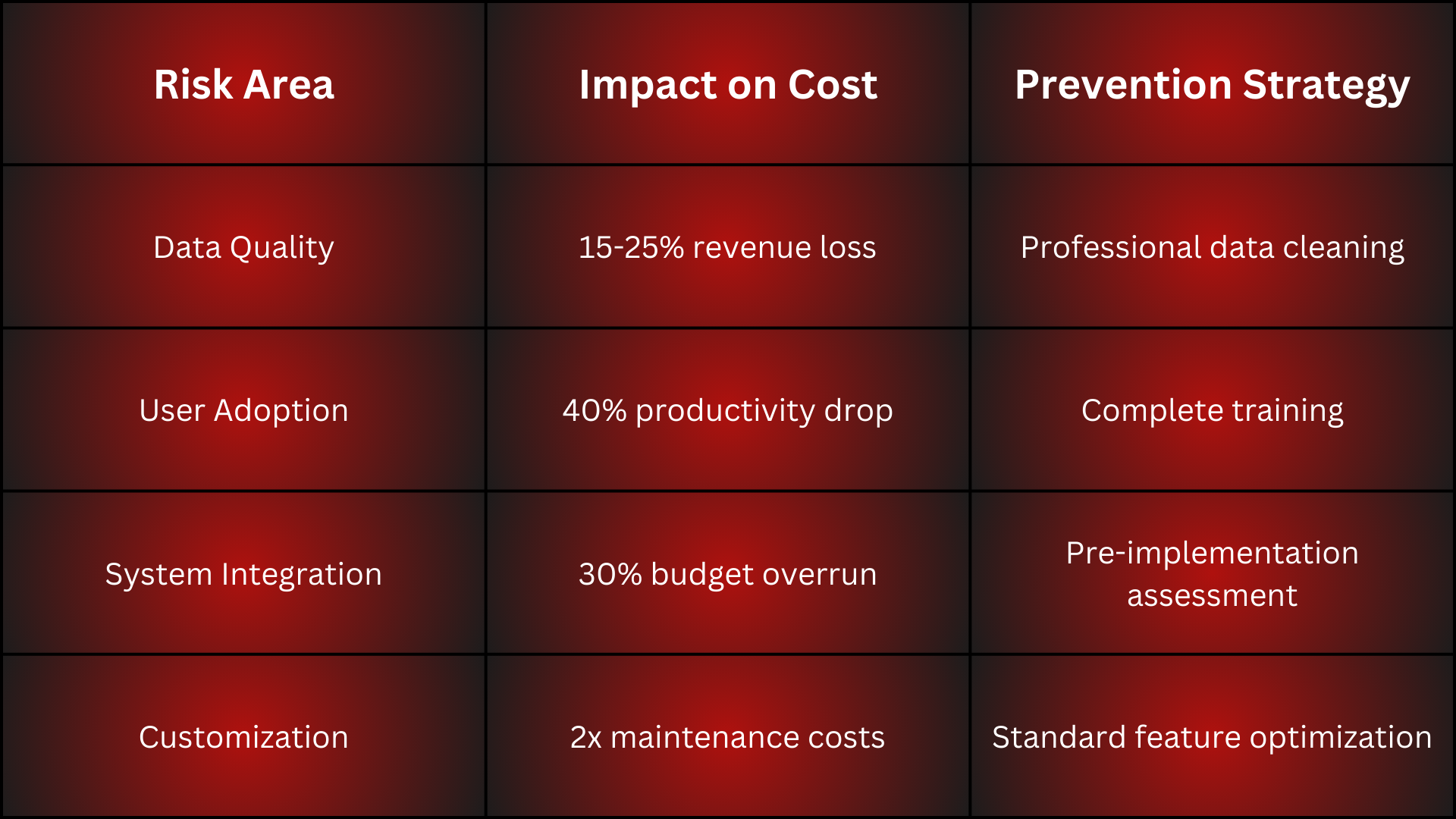
CISIN's implementation services reveal that businesses often miss hidden expenses that affect budget planning. Their experts suggest starting with clear business requirements and goals before beginning technical work.
Contingency planning
Good contingency planning needs 10-20% of the total budget set aside for unexpected costs. Companies should prepare for:
- Technical challenges during data migration
- Extra training requirements
- Integration complications
- Performance optimization needs
- Security compliance updates
A complete disaster recovery strategy helps business continuity. Companies need to document and test recovery procedures regularly. This preparation reduces downtime and keeps data safe during critical situations.
Scope management techniques
A well-defined scope prevents budget overruns and delays. Project managers should set clear boundaries for implementation work. Key strategies include:
- Documentation Requirements
- Business process mapping
- Technical specifications
- User acceptance criteria
- Integration requirements
- Change Control Process
- Formal request procedures
- Impact assessment protocols
- Stakeholder approval workflows
- Budget adjustment mechanisms
Large implementations broken into smaller phases reduce risks. This approach lets organizations:
- Test assumptions early
- Adjust strategies based on feedback
- Control costs effectively
- Maintain project momentum
Project managers must watch scope changes closely. Regular meetings with stakeholders help spot potential issues before they affect the budget. Teams should document all conversations and keep detailed task descriptions.
Data migration needs special attention in scope management. Technical experts must map data objects precisely between systems. This precision helps avoid:
- Data loss or corruption
- Extended migration timelines
- Increased cleanup costs
- Integration failures
User training needs careful scope definition. Companies see better results when they:
- Set clear training goals
- Create role-specific programs
- Measure learning outcomes
- Provide ongoing support
Executive support drives successful implementations. Leadership must take part in:
- Strategic decision-making
- Resource allocation
- Change management
- Risk assessment
Companies should avoid excessive platform customization. Standard features often meet business needs without extra development costs. Customization requires companies to:
- Document business justification
- Assess maintenance implications
- Consider upgrade impacts
- Calculate long-term costs
Team stability affects implementation success. Organizations need to:
- Keep project teams consistent
- Document knowledge transfer steps
- Create backup resource plans
- Set up clear communication channels
Regular system checks help control costs. Teams should review:
- User activity patterns
- System performance metrics
- Integration efficiency
- Data quality indicators
Implementation partners help reduce risks. They assist by:
- Spotting potential issues early
- Suggesting prevention strategies
- Providing technical expertise
- Supporting change management
Budget tracking needs constant attention. Organizations must monitor:
- Actual vs. planned expenses
- Resource utilization rates
- Timeline adherence
- Quality metrics
Conclusion
The cost of implementing Salesforce varies based on your organization's unique requirements. Small businesses typically need to invest $25,000, while enterprise-level implementations can reach $500,000. These numbers might seem high, but companies see average returns of 47% and recover their investment within 3.8 months.
Your success with Salesforce depends on several crucial factors:
- Getting your cost estimates and budget right
- Picking the right implementation partner
- Rolling out the platform in phases
- Managing data quality effectively
- Training users properly
- Having solid risk management plans
CISIN's Salesforce implementation services help businesses get the most value from their investment. Their team of certified experts uses proven methods to guide companies through implementation while keeping costs in check.
Here's what your business needs to focus on:
- Create clear business requirements
- Choose the right Salesforce edition
- Make a solid data migration plan
- Put resources into quality training
- Keep track of implementation progress
- Measure your ROI regularly
Smart planning combined with experienced partners transforms Salesforce investments into real business advantages. Companies that stick to these guidelines see better user adoption, smoother operations, and stronger relationships with their customers.




